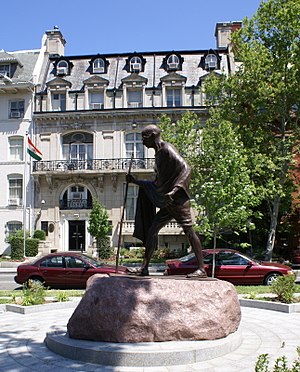Unknown miscreants vandalised the statue of Mahatma Gandhi outside the Indian embassy in Washington DC with graffiti and spray paint, prompting the mission to register a complaint with the local law enforcement agencies.
The vandalism took place during nationwide protests against the custodial killing of George Floyd in Minneapolis on May 25. The incident is reported to have taken place on the night of June 2, officials said.
The Indian embassy has informed the state department and registered a complaint with local law enforcement agencies, which are now conducting an investigation into the incident.
On Wednesday, a team of officials from the Metropolitan Police in consultation with the diplomatic security service and National Park Police visited the site and conducting inquiries.
US ambassador to India Ken Juster on Thursday apologised for the desecration .
“So sorry to see the desecration of the Gandhi statue in Wash, DC. Please accept our sincere apologies. Appalled as well by the horrific death of George Floyd & the awful violence & vandalism. We stand against prejudice & discrimination of any type. We will recover & be better,” Juster tweeted.
Several protests in the US against police brutality against African-Americans have turned violent. In some cases, the violent protests have damaged some of the most prestigious and sacred American monuments.
In Washington, protesters this week burnt a historic church and damaged historic places like the national monument and Lincoln Memorial.
One of the few statues of a foreign leader on a federal land in Washington, Gandhi’s statue was dedicated by former Prime Minister Atal Bihari Vajpayee in the presence of the then US President Bill Clinton on September 16, 2000, during his state visit to the US.
In October 1998, the US Congress had authorised the government of India to establish and maintain a memorial “to honour Mahatma Gandhi on Federal land in the District of Columbia”.
According to the Indian embassy website, Gandhi’s statue is cast in bronze and it is 8 feet high.
It shows Gandhi in stride as a leader and a man of action evoking memories of his 1930 protest march against the salt-tax, and the many padyatras he undertook throughout the length and breadth of the Indian sub-continent.
The statue, the design of which was created by Gautam Pal, is a gift from the Indian Council for Cultural Relations . The pedestal for the statue is a block of new Imperial Red also known as Ruby Red. It originally weighed 25 tonnes.











